Ladybirds
Lucky and useful insects:
Ladybird, ladybird, fly away home. Your
house is on fire and your children are gone. All except one, and that's
little Ann. For she has crept under the warming pan.
 Even
though they are hardly more than 10 millimetres (mm) in size, these
brightly coloured insects which belong to the beetle family have
captured the imagination of authors, poets, artists and even
manufacturers. Even
though they are hardly more than 10 millimetres (mm) in size, these
brightly coloured insects which belong to the beetle family have
captured the imagination of authors, poets, artists and even
manufacturers.
Immortalised in the famous nursery rhyme Ladybird, Ladybird flyaway
home, it has become the favourite insect
|
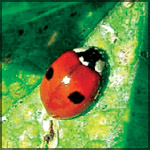
2-spot ladybird |

10-spot ladybird |
|
|
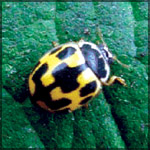
14-spot ladybirds |

14-spot ladybirds |
|
|
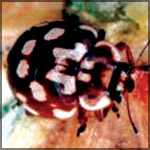
18-spot ladybird |

13-spot ladybird |
|
|

22-spot ladybird |

28-spot ladybird |
|
of many a child. They are treasured through storybooks and
rhymes.
Today, let's fly into the fascinating world of this tiny insect to
find out more about the creature, and why it is considered a mighty
useful insect by most people, especially gardeners.
Ladybirds which belong to the beetle family Coccinellidae are found
worldwide. In fact, there are over 5,000 species with more than 450
species native to North America alone.
There are about 100 species in Europe alone with 40 resident in ihe
British Isles. The largest of the British native is the Eyed ladybird
found in conifer forests and plantations.
Origin of name
You may be puzzled as to why they are called Ladybirds, in English,
Ladybugs in American or Lady beetles by scientists because they are
certainly not all females! Well, there is a fascinating story
surrounding the origin of their name.
According to the most popular story, farmers in Europe were facing
severe hardship long ago due to insects destroying their crops. The
Catholic farmers had then prayed to the Virgin Mary for help.
Then these particular beetles have appeared and started to destroy
all the pests attacking the crops. The farmers had originally named the
insects 'The Beetles of Our Lady' and eventually, they had come to be
known as ladybirds. They didn't differentiate between males and females.
Well, now you know why the word lady is associated with them.
However, this is not the only story about the origin of their name.
Some claim that they are so named, after Freyja, the fertility goddess
in Norse mythology. Ladybirds are considered relics in some ancient
beliefs, and in some cultures, they are known as 'lucky bugs.'
What they look like
Ladybirds have an appealing appearance when compared to most members
in the beetle family. In fact, even
|
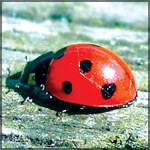
7-spot ladybird |
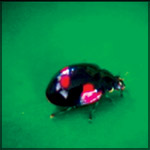
Heather ladybird |
|

Kidney-spot
ladybird |

Larch ladybird |
people who generally hate insects, find ladybirds to be
appealing. The ladybird is a tiny oval-shaped winged insect with six
jointed legs attached to the body as three pairs, one pair of antennae,
and an exoskeleton (external skeleton) made of chitin, (a type of strong
polymer like our hair and nails).
It has a three part body comprising head (mouthparts, compound eyes
and antenna), thorax (middle section with wings and legs) and the
abdomen.
Ladybirds come in a variety of colours, but the most common are
yellow, orange or scarlet with small black spots on wing covers. The
number of spots change according to the species. The legs, head and
antenna are black. With age, the colour of spots fade.
Ladybirds are brightly coloured to ward off predators such as birds.
When threatened, they reflexbleed. They emit an oily, yellow, coloured
toxin called hemolymph from their leg joints and other parts of the body
as a repellent. It has a strong smell.
Life cycle
|
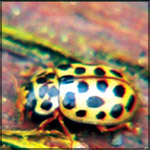
Water ladybird |
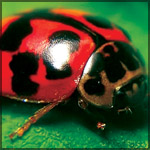 |
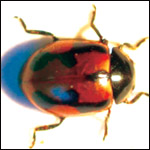
Hieroglyphic ladybird |
The entire life cycle of ladybirds lasts only 4-7 weeks. They go
through the complete metamorphosis; egg, larva, pupa, to adult. They
produce only one generation in a year.
The eggs are usually laid on the underside of a leaf where their
favourite food, aphids (greenflies) or coccids (scale insects) are
found. The tiny 1-2 mm long yellow-coloured, football-shaped eggs are
laid in a cluster.
The eggs, which may number from a few even to a hundred, depending on
the species, are not visible to the
|

Eating an aphid |
|
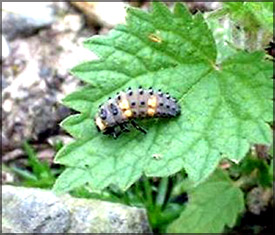
The larva |
naked eye. In most cases, the eggs hatch to a larval stage within a
week.
The mother ladybird also lays infertile eggs as a backup food source.
The ratio with fertile eggs increases, depending on the availability of
food.
Once the eggs hatch, the six-legged larvae, usually black or grey in
colour and about two millimetres in length, look like little monsters,
with their segmented, spiky bodies. They turn grey, black or blue with
yellow and orange markings later.
The larvae have voracious appetites. With their powerful jaws, they
eat away up to 25 aphids a day and keep growing in size.
|
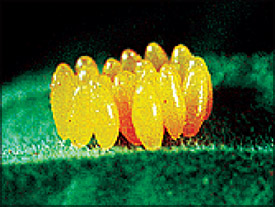
Eggs laid where aphid are in plenty. Inset - enlarged picture of
eggs. |
Then they attach themselves to the underside of leaves and enter the
pupal stage. When they become adults, the ladybirds eat around 50 aphids
a day.
If food is scarce during the larval stage, they even eat each other!
The larvae changes skin four times before they pupate, or turn into
adults. This is because the skin doesn't grow, but splits.
***
Fact file
* Not all ladybirds are predators. There are some which are
herbivores such as the yellow and black, 22 spot ladybirds. They eat
mildew and other microscopic fungi which grow on plant tissue.
* The 14-spot ladybird is rather unusual in that it has squarish
spots on a golden-yellow background. Even the striped ladybird and the
cream-streaked ladybird have uncommon markings.
* Ladybirds have varying numbers of spots. There are 2-spot
ladybirds, 5-spot ladybirds, 7-spot ladybirds, 10-spot ladybirds,
11-spot ladybirds, 14-spot ladybirds, 16-spot ladybirds, 18-spot
ladybirds, 22-spot ladybirds and 24-spot ladybirds (found mostly in
Britain). The commonest ladybird is the 2-spot.
* The Heather ladybird, Cream-spot ladybird, Kidney-spot ladybird,
Water ladybird, Hieroglyphic ladybird, Orange ladybird, Adonis ladybird,
Larch ladybird, Pine ladybird and Eyed ladybird are also found in
Britain.
* Their antennae have little knots at the end and this type of
antennae are called 'clubbed antennae.'
* When the temperature is 59 degrees Fahrenheit, most ladybirds are
very active. They hibernate in cold weather - until about late March.
Eggs are laid in late spring and both larvae and adults eat throughout
the summer.
* Ladybirds are harmless to humans, but can be poisonous to most big
or small birds.
* A few species of ladybirds are kept as pets in North America.
* They hibernate in sheltered places among dense vegetation, leafy
litter, under tree parts and even buildings.
* The Harlequin ladybird (7.8mm long) is an Asian species introduced
to North America.
* Ladybirds play dead when threatened.
* When ladybirds are not flying, their flight wings are covered and
protected by a modified pair of wings called elytra. When they are
flying, the elytra open up, allowing the wings to move.
* In 1999 four ladybirds, named John, George, Paul and Ringo, after
the famous pop group The Beatles, were sent on a space mission to check
their ability to survive in space. They are said to have survived the
mission. So, ladybirds can live in space too!
* In myths and legends, ladybirds are considered a symbol of good
luck.
* They sense for food with their antennae.
* Ladybirds can be identified separately from other beetles by their
short legs.
* They are cold blooded creatures.
* Their top flying speed is 15 miles per hour.
* Herbivorous or non predatory ladybirds are destructive to foliage
and crops such as potatoes.
* They range from 1 mm to 10 mm in length, depending on species and
is oval and dome shaped.
* Newly hatched larvae are less than 4 mm long and grey or black in
colour. The markings come as they grow.
* There are many subfamilies such as Scymninae, Chilocorinae and
Epilachninae found in Australia and elsewhere. |
